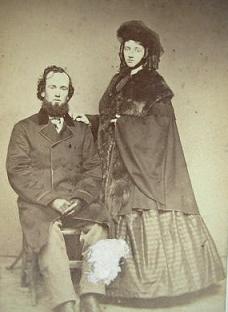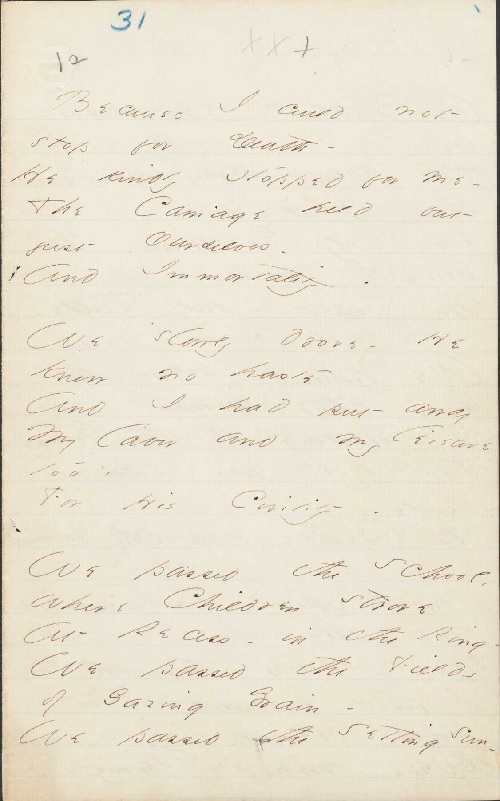Faculty of Arts,
Chulalongkorn University
"Because I could not stop for death—"
(1890)
Emily
Dickinson
(December 10, 1830 – May 15, 1886)
Because
I could not stop for Death –
|
|
He
kindly stopped for me –
|
|
The
Carriage held but just Ourselves –
|
|
And
Immortality.
|
|
|
|
We
slowly drove – He knew no haste
|
5
|
And
I had put away
|
|
My
labor and my leisure too,
|
|
For
His Civility –
|
|
|
|
| We passed the School, where Children
strove |
|
| At Recess – in the Ring – |
10
|
| We passed the Fields of Gazing Grain
– |
|
| We passed the Setting Sun – |
|
| |
|
| Or rather – He passed Us – |
|
| The Dews drew quivering and chill – |
|
| For only Gossamer, my Gown – |
15
|
| My Tippet – only Tulle – |
|
| |
|
| We paused before a House that seemed |
|
| A Swelling of the Ground – |
|
| The Roof was scarcely visible – |
|
| The Cornice – in the Ground – |
20 |
|
|
| Since then – 'tis Centuries – and yet |
|
| Feels shorter than the Day |
|
| I first surmised the Horses' Heads |
|
| Were toward Eternity – |
|
Notes
16 tippet:

|
- tippet (Merriam-Webster)
1: a long hanging end of cloth attached to a sleeve, cap,
or hood
2: a shoulder cape of fur or cloth often with hanging
ends.
- tippet (Encyclopædia
Britannica)
Tippet, long, narrow, cloth streamer, usually white, worn around
the arm above the elbow, with the long end hanging down to the
knee or to the ground. These graceful tippets, worn in the late
14th century by both men and women, developed out of the long
flaps created by the narrow 14th-century sleeve.
In the 15th century, the designation tippet came to signify a
long streamer (also called liripipe) extending from a hat or
hood. Tippet may also refer to an 18th-century capelike or
scarflike garment worn around the neck and hanging down in
front; this tippet could be made of gauze, crepe, lace, velvet,
fur, or feathers. [...]
|
What
was the United States like that Whitman and Dickinson were born into?
Source: Ed
Folsom, Selected American Authors: Emily Dickinson and Walt Whitman
EMILY DICKINSON is
born in 1830, the year President Andrew Jackson signs the Great Removal
act, forcibly resettling all Indians west of the Mississippi; Jackson
addresses the nation, "What good man would prefer a country covered with
forests and ranged by a few thousand savages to our extensive Republic,
studded with cities, towns, and prosperous farms, embellished with all the
improvements which art can devise or industry execute?" The Sac and Fox
tribes, over objections of chief Black Hawk, give up all their lands east
of Mississippi River ; Choctaws do the same; other tribes like Chickasaws
follow suit within a year or two. Only the Cherokees, literate farmers who
wanted citizenship, hold out. In 1832, Black Hawk leads some Sac and Fox
back across Mississippi into Illinois --they are eventually ambushed and
massacred in the Michigan Territory , and Black Hawk is turned over to
U.S. authorities by the Winnebago Indians. Major Congressional debate is
over whether or not the sale of Western lands should be restricted;
Western senators sense a plot by Eastern business interests to close the
West so that cheap labor stays in the Northeast where factories demand
low-paid workers. Joseph Smith publishes "The Book of Mormon", based on
his deciphering of golden plates he claimed to have found on an upstate
New York mountain, detailing the true church as descended through American
Indians who were apparently part of the lost tribes of Israel (an idea
quite common in early 19th-century America). The next year, 1831, Alexis
de Tocqueville arrives in the U.S. and begins his journey around the
country that would result in his massive book of observations, "Democracy
in America ," including his analysis of “the three races in America ”
(black, red, and white). Nat Turner, a Virginia slave who had visions from
God of white spirits and black spirits engaged in bloody combat, leads a
revolt with seven other slaves, killing his master and his family; with 75
insurgent slaves, he killed more than 50 whites on a two-day journey to
Jerusalem, Virginia, where he was hanged along with sixteen of his
companions (many other blacks are killed during the manhunt for Turner).
The Turner Insurrection was the stuff of nightmares for white Southerners,
who passed increasingly severe slave codes. The song "America" is sung for
the first time in Boston on July 4.
Poetry
If I read a book and it makes my whole body so cold no fire can warm me I
know that is poetry. If I feel
physically as if the top of my head were taken off, I know that
is poetry. These are the only way I know it. Is there any other
way?
Dickinson’s editing process often focused on word choice rather than on
experiments with form or structure. She recorded variant wordings with a “+”
footnote on her manuscript. Sometimes words with radically different
meanings are suggested as possible alternatives. [...] Because Dickinson did
not publish her poems, she did not have to choose among the different
versions of her poems, or among her variant words, to create a "finished"
poem. This lack of final authorial choices posed a major challenge to
Dickinson’s subsequent editors.
—"
Diction,"
Major Characteristics of Dickinson's Poetry, Emily Dickinson Museum (2009)
Poems (1890)
|
|
Because I could not stop for
Death –
He kindly stopped for me –
The Carriage held but just Ourselves –
And Immortality.
We slowly drove – He knew no haste
And I had put away
My labor and my leisure too,
For His Civility –
We passed the School, where Children strove
At Recess – in the Ring –
We passed the Fields of Gazing Grain –
We passed the Setting Sun –
Or rather – He passed us –
The Dews drew quivering and chill –
For only Gossamer, my Gown –
My Tippet – only Tulle –
We paused before a House that seemed
A Swelling of the Ground –
The Roof was scarcely visible –
The Cornice – in the Ground –
Since then – ‘tis Centuries – and yet
Feels shorter than the Day
I first surmised the Horses’ Heads
Were toward Eternity – |
1
2
3
4
5
6
7
8
9
10
11
12
13
14
15
16
17
18
19
20
21
22
23
24 |
|
Study Questions
- What is the difference between dictionary definitions and
Dickinson's meanings?
- How do the dashes and line breaks affect the meaning of the
poem?
|
Vocabulary
fascicle
lyric
diction; denotation, connotation
ambiguity
circumlocution
definition; definition poem
irony
pathos
logos
form
stanza
meter; common meter
rhyme
repetition
punctuation; dash
imagery
tone
theme
Sample
Student
Responses to Emily Dickinson's "Because I could not stop for Death—"
Response
1:
Reference
| Link |
Texts
Secondary Texts
Textual Criticism
Resources
|
Emily
Dickinson
|
- Emily
Dickinson (brief bio)
- Emily
Dickinson (longer biography)
- Karen Ford, ed., "Emily
Dickinson (1830–1886)," Modern
American Poetry, University of Illinois at
Urbana-Champaign
- Emily
Dickinson Museum (biography,
schooling,
faith,
health,
death,
family
and friends, letters,
poetry
characteristics)
|
Reference
Dickinson, Emily. The
Complete Poems of Emily Dickinson. Ed. Thomas H. Johnson.
Boston: Little, Brown, 1960. Print.
Further
Reading
Dickinson, Emily. The Letters of Emily
Dickinson. Ed. Thomas H. Johnson. Cambridge: Belknap, 1958. Print.
Eberwein, Jane
Donahue, Stephanie Farrar, and Cristanne Miller, eds. Dickinson
in Her Own Time: A Biographical Chronicle of Her Life, Drawn from
Recollections, Interviews, and Memoirs by Family, Friends, and
Associates. Iowa: U of Iowa P, 2015. Print.
Grabher,
Gudrun, Roland Hagenbüchle, and Cristanne Miller, eds. The
Emily Dickinson Handbook. Amherst: U of Massachusetts P, 1998.
Print.
Griffith,
Clark. The Long Shadow: Emily
Dickinson's Tragic Poetry. Princeton: Princeton UP, 1964. Print.
Kirby, Joan. Emily Dickinson. New York: St.
Martin's Press, 1991. Print.
Martin,
Wendy. The Cambridge Companion to Emily
Dickinson. Cambridge: Cambridge UP, 2002. Print.
Martin,
Wendy. The Cambridge Introduction to
Emily Dickinson. Cambridge: Cambridge UP, 2007. Print.
Miller,
Cristanne. Emily Dickinson: A Poet's
Grammar. Cambridge: Harvard UP, 1989. Print.
Miller,
Cristanne. Reading in Time: Emily
Dickinson in the Nineteenth Century. Amherst: U of Massachusetts
P, 2012. Print.
Mitchell,
Domhnall. Emily Dickinson: Monarch of
Perception. Amherst: U of Massachusetts P, 2000. Print.
Sewall,
Richard B. The Life of Emily Dickinson.
New York: Farrar Straus and Giroux, 1974. Print.
Smith,
Martha Nell, and Mary Loeffelholz, eds. A
Companion to Emily Dickinson. Malden, MA: Blackwell, 2008. Print.
Socarides,
Alexandra. Dickinson Unbound: Paper,
Process, Poetics. Oxford: OUP, 2014. Print.
Home | Reading and Analysis for the Study of
English Literature | Literary Terms | English Help
Last updated March 14, 2018

